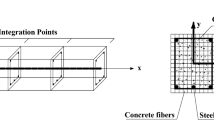Abstract
In this study, the use of the displacement-based fibre element (DBFE) method for modelling the nonlinear seismic response of reinforced concrete shear wall structures with a variation of damping ratios and types of structural damping is evaluated. The experimental seismic responses of the CAMUS I and NEES-UCSD shear wall structures are compared with nonlinear time-history analysis results obtained using the DBFE method. Comparisons are made in terms of the absolute maximum values of the top displacement, the base shear force, the base bending moment values and minimum differences between overlaps of top displacement time-history graphs. The Hilber-Hughes-Taylor-α integration method is selected for the dynamic solution algorithm. Recommendations are made for appropriate damping ratios for stiffness-proportional, mass-proportional, and Rayleigh damping to be used for the structural damping of nonlinear seismic analyses of the shear walls. The minimum difference between experimental and numerical analysis results is obtained less than 11% using Rayleigh damping. Additionally, the optimal number of fibre elements is researched with regard to the ratio of the mean length of the fibre elements to the longitudinal length of the shear wall. When the ratio is smaller than 3%, the differences between experimental and numerical analysis results for both shear walls are less than 2% at the optimal damping ratios.
























Similar content being viewed by others
References
Chong X, Xie L, Ye X, Jiang Q, Wang D (2019) Experimental study on the seismic performance of superimposed RC shear walls with enhanced horizontal joints. J Earthq Eng 23(1):1–17. https://doi.org/10.1080/13632469.2017.1309604
Dazio A, Beyer K, Bachmann H (2009) Quasi-static cyclic tests and plastic hinge analysis of RC structural walls. Eng Struct 31(7):1556–1571. https://doi.org/10.1016/j.engstruct.2009.02.018
Zhang J, Zheng W, Yu C, Cao W (2018) Shaking table test of reinforced concrete coupled shear walls with single layer of web reinforcement and inclined steel bars. Adv Struct Eng 21(15):2282–2298. https://doi.org/10.1177/1369433218772350
Sengupta P, Li B (2014) Hysteresis behavior of reinforced concrete walls. J Struct Eng 140(7):04014030. https://doi.org/10.1061/(ASCE)ST.1943-541X.0000927
Sengupta P, Li B (2016) Seismic fragility assessment of lightly reinforced concrete structural walls. J Earthq Eng 20(5):809–840. https://doi.org/10.1080/13632469.2015.1104755
Zhang Z, Li B (2018) Effective stiffness of non-rectangular reinforced concrete structural walls. Earthq Eng 22(3):382–403. https://doi.org/10.1080/13632469.2016.1224744
Li S, Wu C, Kong F (2019) Shaking table model test and seismic performance analysis of a high-rise RC shear wall structure. Shock Vib 5:1–17. https://doi.org/10.1155/2019/6189873
Orakcal K, Wallace JW, Conte JP (2004) Flexural modeling of reinforced concrete walls-model attributes. ACI Struct J 101:688–698. https://doi.org/10.14359/13391
Martinelli L, Martinelli P, Mulas MG (2013) Performance of fiber beam-column elements in the seismic analysis of a lightly reinforced shear wall. Eng Struct 49:345–359. https://doi.org/10.1016/j.engstruct.2012.11.010
Lu X, Xie L, Guan H, Huang Y, Lu X (2015) A shear wall element for nonlinear seismic analysis of super-tall buildings using OpenSees. Finite Element Anal Des 98:14–25. https://doi.org/10.1016/j.finel.2015.01.006
Vásquez JA, Juan C, de LaLlera MH (2016) A regularized fiber element model for reinforced concrete shear walls. Earthq Eng Struct Dyn 45:2063–2083. https://doi.org/10.1002/eqe.2731
Li G, Yu DH, Li HN (2018) Seismic response analysis of reinforced concrete frames using inelasticity-separated fiber beam-column model. Earthq Eng Struct Dyn 47(5):1291–1308. https://doi.org/10.1002/eqe.3018
Fritz WP, Jones NP, Igusa T (2009) Predictive models for the median and variability of building period and damping. J Struct Eng 135(5):576–586. https://doi.org/10.1061/(ASCE)0733-9445(2009)135:5(576)
Gilles D, McClure G (2012) In situ dynamic characteristics of reinforced concrete shear wall buildings. Structures Congress 2012, Chicago, Illinois, pp. 2235–2245. https://ascelibrary.org/doi/10.1061/9780784412367.196
Seismosoft (2016) A computer program for static and dynamic nonlinear analysis of framed structures. Available from https://www.seismosoft.com
Gharakhanloo A, Kaynia AM, Tsionis G (2015) Distributed and concentrated inelasticity beam-column elements: application to reinforced concrete frames and verification. In: 5th International Conference on computational methods in structural dynamics and earthquake engineering methods in structural dynamics and earthquake engineering, Crete Island, Greece, pp. 3694–3703. https://doi.org/10.7712/120115.3650.506
Øystad-Larsen N, Cemalovic M, Kaynia AM (2016) Investigation of overstrength of dual system by non-linear static and dynamic analyses. Int J Geol Environ Chem Ecol Geol Geophys Eng 10(2):228–238. https://doi.org/10.5281/zenodo.1112061
Karaton M (2014) Comparisons of elasto fiber and fiber Bernoulli–Euler reinforced concrete beam-column elements. Struct Eng Mech 51(1):89–110. https://doi.org/10.12989/sem.2014.51.1.089
Martinelli P (2007) Shaking table tests on rc shear walls: significance of numerical modeling. Dissertation, Politecnico di Milano, Italy
Kolozvari K, Tran TA, Orakcal K, Wallace JW (2015) Modeling of cyclic shear-flexure interaction in reinforced concrete structural walls II: experimental validation. J Struct Eng 141(5):04014136. https://doi.org/10.1061/(ASCE)ST.1943-541X.0001083
Mander JB, Priestley MJ, Park R (1988) Theoretical stress–strain model for confined concrete. J Struct Eng 114(8):1804–1826. https://doi.org/10.1061/(ASCE)0733-9445(1988)114:8(1804)
Menegotto M, Pinto PE (1973) Method of analysis for cyclically loaded RC plane frames including changes in geometry and non-elastic behaviour of elements under combined normal force and bending. In: Proceedings of IABSE symposium on resistance and ultimate deformability of structures acted on by well defined repeated loads, Lisbon, pp. 15–22
Correia AA, Virtuoso FBE (2006) Nonlinear analysis of space frames. In: Proceedings of the Third European Conference on computational mechanics: solids, structures and coupled problems in engineering, Springer, Dordrecht, Lisbon, Portugal, pp. 107–107. https://doi.org/10.1007/1-4020-5370-3_107
Kazaz I, Yakut A, Gülkan P (2006) Numerical simulation of dynamic shear wall tests: a benchmark study. Comput Struct 84(8–9):549–562. https://doi.org/10.1016/j.compstruc.2005.11.002
Martinelli P, Filippou FC (2009) Simulation of the shaking table test of a seven-story shear wall building. Earthq Eng Struct Dyn 38(5):587–607. https://doi.org/10.1002/eqe.897
Calayir Y, Karaton M (2005) A continuum damage concrete model for earthquake analysis of concrete gravity dam-reservoir systems. Soil Dyn Earthq Eng 25(11):857–869. https://doi.org/10.1016/j.soildyn.2005.05.003
ACI 318-02 (1999) Building code requirements for structural concrete and commentary. American Concrete Institute, Farmington Hills, USA
Celep Z, Kumbasar N (2004) Deprem mühendisliğine giriş ve depreme dayanıklı yapı tasarımı. Beta Dagitim, Istanbul, Turkey (In Turkish)
Acknowledgements
This research has been obtained from Ömer Faruk Osmanlı's M.Sc. thesis results and we would like to thank Mehmet Eren Gülşan and Muhammet Karaton, supervisors of this thesis.
Author information
Authors and Affiliations
Corresponding author
Rights and permissions
About this article
Cite this article
Karaton, M., Osmanlı, Ö.F. & Gülşan, M.E. Investigation of Uncertainties in Nonlinear Seismic Analysis of the Reinforced Concrete Shear Walls. Int J Civ Eng 19, 301–318 (2021). https://doi.org/10.1007/s40999-020-00567-8
Received:
Revised:
Accepted:
Published:
Issue Date:
DOI: https://doi.org/10.1007/s40999-020-00567-8




